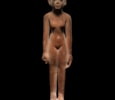Wooden Nubian Woman
A hand-carved wooden female figure in striding pose, with her true left leg extended ahead. She is depicted in the nude, and delicately modelled, with a slender waist and small breasts. Her head is clean shaven, except for a circular tuft of hair on her crown – a hairstyle associated with Nubians, but also popular among young Egyptian women in the 18th Dynasty.1 Her arms hang by her sides, with one hand in a fist, pierced horizontally, suggesting it may originally have held an object. As there are no other attachments for other parts, it suggests that this was originally a free-standing sculpture, rather than incorporated into a cosmetic item, as was popular for figures of female youths at the time. It is unusual for a wooden figure of this time to have been carved out of one block of wood, as is the case for this example – this demonstrates a high level of skill from the craftsman who made it.
This type of small wooden statuette was common in the second part of the 18th Dynasty, particularly during the reign of Amenhotep III. The image of a nude, adolescent girl is imbued with notions of sexuality, fertility, birth, and rebirth into the next world. This figure may well have served a similar purpose to the tomb statuette of Amenemheb now in the Metropolitan Museum of Art, New York (26.7.1413a, b).2 This nude figure of a young boy holds a lotus in his fist, and was found in his mother’s coffin, dedicated by his father alongside a figure of his brother, Huwebenef, who is depicted in the same striding pose as the female figure, with a pierced hand for an attachment.
The Collector’s Eye: Masterpieces of Egyptian Art from the Thalassic Collection, Ltd., Michael C. Carlos Museum, Emory University, Atlanta, US, 11 April 2001 – 6 January 2002, no. 50.
Dr. Ludwig Pollak, Joseph v. Kopf als Sammler (Rome, 1905), no. 266, pl. XI.
Jacques Chamay, Jiří Frel, Jean-Louis Maier, Le Mondes de Cesars (Musée d’art et d’histoire de Genève, 1982), end page.
Peter Lacovara, Betsy Teasley Trope, Sue H. D’Auria (eds.), The Collector’s Eye: Masterpieces of Egyptian Art from the Thalassic Collection, Ltd., exhibition catalogue, Michael C. Carlos Museum, Emory University, Atlanta, 2001, no. 50, p. 91.
Private Collection of Joseph von Kopf (1827-1903), Rome.
Thence by descent to his wife, Mrs. von Kopf, Rome, 1903.
With Joseph Altounian (1889-1954), Paris and Mâcon, by at least 1954, accompanied by a stamped photograph.
With Daphné Zimmerman-Koutoulakis, Geneva, by at least 1982.
Private Collection of Theodore Halkedis (1932-2001) and Aristea S. Halkedis (1933-2014), ‘The Thalassic Collection’, New York, 1990s-2014.
Private Collection of Sheikh Saud bin Mohammed Al Thani (1966-2014), London, acquired from the above via Christie’s New York Private Treaty (along with the whole Thalassic collection) on/around 25th June 2002.
Thence by descent, London.
ALR: S00254288, with IADAA Certificate, this item has been checked against the Interpol database.
Joseph von Kopf (1827-1903) was born on 10 March 1827, to a farmer and owner of a brickworks in Unlingen, Germany. Kopf spent his youth in the brickworks, and was only given artistic training at the age of 21. He apprenticed with stonemasons and grave sculptors in Ravensburg and Bal Waldsee, and then worked at the studios of various German sculptors. He moved to Rome in 1852, and opened his first studio there in 1855. Originally working the Nazarene style, he soon moved towards classical realism and portrait sculpture, which makes up the main body of his work. The Grand Duke of Baden established a studio for Kopf in Baden-Baden, where he spent every summer from 1874 onwards, and was frequently visited by eminent travellers to the spa. Kopf died in Rome on 2 February 1903, and was known as one of the most famous German artists of his time.










 Enquire
Enquire




